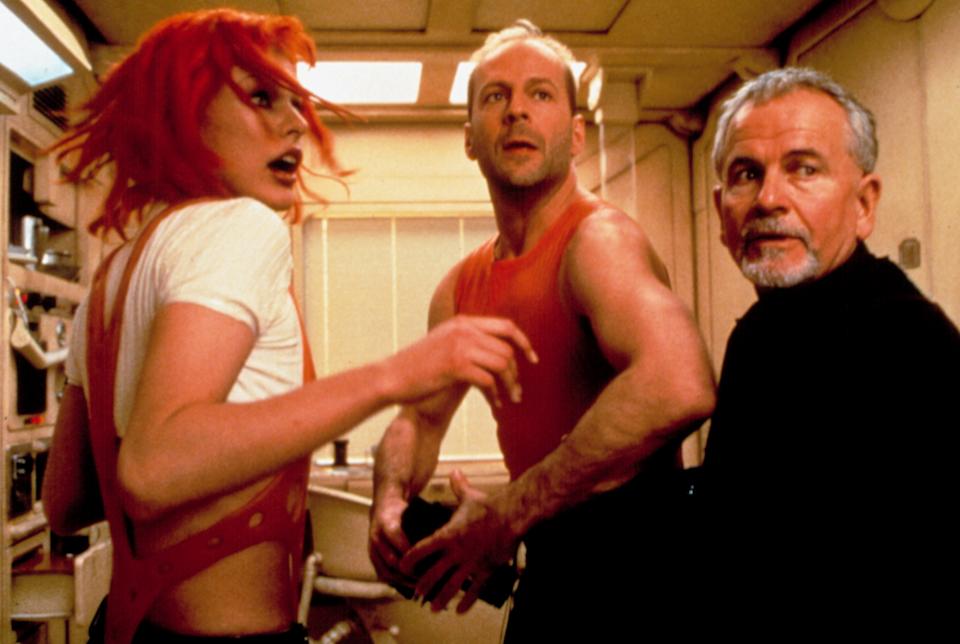Sometimes a career makeover also requires a personal makeover. Twenty-five years ago, Bruce Willis — who recently “stepped away” from acting after his family publicly disclosed his aphasia diagnosis — took a major professional risk by attaching himself to the gonzo Gallic sci-fi film, The Fifth Element, directed by French action maestro Luc Besson. And the first thing the Die Hard star did to prepare himself for the role of futuristic soldier-turned-flying taxicab driver, Korben Dallas, was debut a new head of hair.
“Luc had for some reason dyed his hair blond,” Willis revealed to Entertainment Weekly in 2017. “And I said, ‘You know what? I should dye my hair blond, have a little wig on my head.’ That was a contribution of mine, and he liked it.”
Released in theaters on May 9, 1997, The Fifth Element catapulted Willis into the far-off year of 2263, where he inadvertently rescues a mysterious alien named Leelo (Milla Jovovich) — the living embodiment of the “Fifth Element” that’s essential to saving the world from an approaching evil. It was the star’s second excursion into sci-fi after Terry Gilliam’s Twelve Monkeys, and it came at a time when Willis was getting choosier in his action vehicles after seemingly wrapping up the Die Hard franchise with 1995’s Die Hard with a Vengeance, and finding acclaim in smaller movies like Pulp Fiction and Nobody’s Fool.
[embedded content]
“People in the media try to identify me and say, ‘He’s this kind of actor’ or ‘He’s this superstar’ or whatever label they put on me,” he remarked in one interview. “I’m still learning how to act. It would be very easy for me and also very boring for me to just do action movies all the time. I am tired of it, so I try to find other things to challenge myself.”
It’s worth noting that Willis wasn’t Besson’s first pick to play Korben. In a 2017 Reddit AMA, the director revealed he originally pitched the project to Mel Gibson, who was coming off of Braveheart and Ransom. “I had asked Mel Gibson first because he had his office next to mine at Warner Brothers,” Besson said. “He peeked into my office every morning to tell me that he was thinking about it. After three months, he passed. Bruce was the only other choice I had in my mind.”
Without exactly coming out and saying it, it sounds as if Willis wasn’t entirely sold on The Fifth Element when Besson presented him with the script and some of his elaborate concept art for the 23rd-century Earth. The actor called the aesthetic of the film “very strange” in a pre-release interview. And the character of Korben has to navigate through that strange landscape by quickly adapting to the bizarre creatures and places he encounters — moments almost designed to push Willis out of his comfort zone. But that was a challenge he felt compelled to take on. “I like to do films that I’m not quite sure whether I’m going to succeed in, so there’s always that risk of failure,” he noted.
Willis demonstrated his commitment to The Fifth Element by showing up to set with his blond dye-job, earning a thumbs up from Besson. But he had other ideas that the director wasn’t so keen on. In a 2017 interview with Screen Rant, Besson said that Willis’s assistant approached him early on in the shoot, and outlined the star’s preferred working schedule, one that minimized the amount of time he’d have to spend on set in between camera set-ups for the next shot. “[The assistant] said, ‘Okay, I’m going to tell you how it works,'” the filmmaker recalled. “We need a pre-call at 30 mins, then a pre-call at 15 mins, then a pre-call at 5 mins before he goes on set.'”
That approach clashed with Besson’s own rapid-fire directing process, which required the actors to remain on set and ready to go at faster intervals. “I said, ‘I make a shot every four minutes. Are you kidding?’ And he said, ‘What do you mean, you do a shot every four minutes?’ I do the shot and then I turn the camera around and I do another shot, so I can’t warn you 30 minutes before the shot.”
After some negotiation with Willis directly, Besson arrived at a compromise that would keep Willis on set, but give him extra-long weekends. “I said [to Bruce] ‘what about rather than working 5 days … you work for four days per week? Monday, Tuesday, Wednesday, Thursday, but you sit on the box next to me by the camera and we shoot like crazy, and he said okay! Deal! So he was like on the entire set like 10 feet from the camera on a box and he was so happy. Because he preferred it shorter and tenser.”
Speaking with EW, Willis discussed the effects of his shift to a four-day workweek. “We had long days, and we’d just have to work and work and keep it moving quickly,” the actor said. “Luc does a lot of takes. But that’s part of the film business, and I didn’t have any problem with it.” But Fifth Element co-writer, Robert Kamen, has a different memory of Willis’s attitude. “[Bruce] was very difficult, and Luc worked around it,” he told Uproxx in 2021. “But Luc wasn’t used to it. After he did that, he came to me and said, ‘We have to create our own movie stars.’ And that’s what we did with The Transporter. We created Jason [Statham].”
In the end, Willis was probably right in suspecting that The Fifth Element was a little too strange for American audiences. The film met with mixed critical and commercial success stateside, only earning a little over $60 million during its run. But it tripled those numbers globally, hitting the $200 million mark and placing it among the actor’s top 10 highest grossing star vehicles alongside the Die Hard sequels, Armageddon and The Sixth Sense.
Willis would increasingly come to bank on his international stardom as he entered the 2000s and his leading roles gradually gave way to supporting appearances. Both of his latter-day Die Hard sequels — 2007’s Live Free or Die Hard and 2013’s A Good Day to Die Hard — grossed far more abroad than they did in the U.S., as did action fare like G.I. Joe: Retaliation and RED, where he was one of several globally-recognized faces on the poster.
That set the stage for Willis’s most recent pre-retirement career act as a regular presence in low-budget movies that were financed and sold internationally on the strength of his popularity overseas. As on The Fifth Element, the actor had a reduced workweek for those roles, especially as the effects of his illness became more pronounced. Following his family’s March statement about his aphasia diagnosis, the Los Angeles Times reported that Willis’s on-set time was often limited to two days, and he received $2 million for each film. The story also noted that several of the directors and cast members who worked with Willis on those movies were concerned about his health and whether or not the actor’s representatives had his best interests at heart.
In the wake of The Fifth Element‘s international success — and before Willis’s health declined — Besson hoped to craft a second adventure for Korben and Leeloo out of the additional 180 pages of equally strange material that he tacked on to the original script. “We were going to do it as a sequel, but it made no sense, and The Fifth Element wasn’t big enough here,” Kamen revealed to Uproxx. “It was huge in the rest of the world, and it’s a classic, but it only did $75 million here or $80 million.” (In 2018, multiple women came forward to accuse Besson of sexual misconduct; the director hasn’t helmed a movie since 2019’s little-seen Anna.)
For his part, Willis has indicated that he was fine with The Fifth Element remaining a one-and-done experiment, even as the film helped shape the second half of his career. “I haven’t talked about the movie since we finished,” he told EW in 2017. “It was a great cast and a great film. I just don’t really dissect the work that we do on a day-to-day basis.”
The Fifth Element is currently streaming on Paramount+




